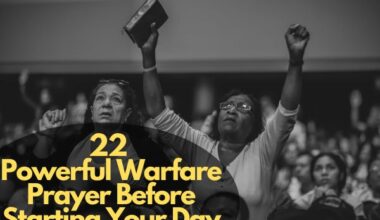Prayer Postures In The Bible have become very significant as we travel through the pages of the scriptures. In biblical worship, prayer is more than just words—it also involves the worshiper’s physical position.
The Bible gives a clear picture of how God’s children have approached Him throughout history, from bending in humble surrender to standing in bold trust. Come along on a spiritual journey as we examine the various prayer positions described in the Bible, deciphering the rich significance of each motion and attempting to comprehend the private conversation between God and humanity.
Prayer Postures In The Bible
Prayer, the act of reaching out to the divine, is a universal human experience. While words form the core of prayer, the Bible reveals that our physical posture can also play a significant role in expressing our devotion and aligning our hearts with God.
Throughout the scriptures, we encounter a rich tapestry of prayer postures, each reflecting the nuances of human emotions and spiritual yearnings. Let’s embark on a journey through the Bible, exploring how different postures enhance the journey of prayer:
1. Standing: A posture of reverence and alertness, standing embodies our readiness to engage with God. King Solomon, at the dedication of the temple, stood before the Lord, stretching out his hands towards heaven (1 Kings 8:22). This act symbolizes openness and receptivity, acknowledging God’s presence and seeking His guidance.
2. Kneeling: A gesture of humility and submission, kneeling signifies our recognition of God’s sovereignty and our dependence on Him. Jesus, in the Garden of Gethsemane, knelt and prayed, demonstrating His vulnerability and surrender to God’s will (Luke 22:41). Kneeling can be a powerful way to express our reverence and seek God’s mercy.
3. Sitting: A posture of contemplation and reflection, sitting allows us to quiet our minds and focus on God’s word. Hannah, after dedicating her son Samuel to the Lord, sat before Him and prayed (1 Samuel 2:1). This act suggests a deliberate time of communion and meditation on God’s faithfulness.
4. Prostrating: A gesture of utter humility and surrender, prostrating oneself before God signifies complete submission to His will. Moses, after receiving the Ten Commandments, fell face down in worship before the Lord (Exodus 34:8). This act expresses awe and reverence, acknowledging God’s majesty and power.
5. Lifting Hands: A posture of openness and receptivity, lifting hands signifies our desire to receive from God and surrender our burdens to Him. David often prayed with lifted hands, expressing his dependence on God’s grace and seeking His protection (Psalm 141:2). This gesture symbolizes surrender and trust in God’s power.
6. Bowing: A posture of humility and respect, bowing signifies our recognition of God’s greatness and our desire to align ourselves with His will. Jesus, during His prayer on the cross, bowed His head and yielded His spirit to the Father (John 19:30). This act demonstrates submission to God’s plan and ultimate acceptance of His will.
7. Lying Face Down: A posture of desperation and vulnerability, lying face down expresses deep sorrow, repentance, and urgent pleas to God. Elijah, discouraged and overwhelmed, lay face down on the ground, seeking God’s guidance and renewal (1 Kings 19:4). This act reflects vulnerability and dependence on God’s mercy in times of hardship.
Beyond Postures
It’s important to remember that prayer postures are not dictated by rigid rules or prescribed formulas. The Bible emphasizes the sincerity of the heart over outward expressions (Isaiah 29:13). While postures can enhance our focus and deepen our connection with God, the true essence of prayer lies in the authenticity of our hearts and the depth of our faith.
Conclusion
The exploration of prayer postures in the Bible reveals a fascinating interplay between our physical expressions and spiritual communion. From the reverence of standing to the vulnerability of lying down, each posture offers a unique lens through which we engage with God. As we look deeper into the scriptures, let us remember that the most powerful prayer is not defined by the position of our bodies but by the sincerity of our hearts, for it is there that we truly meet the divine.
A universal truth may be found in the mosaic of biblical prayers: God, in His infinite grace, hears our petitions not only in the words we speak but also in the sincerity of our physical emotions. We hope that this investigation will lead to a closer relationship with the Creator as we persistently seek Him out in prayer, reverence, and sincerity.




